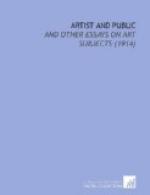The comparison with Michelangelo is inevitable and has been made again and again by those who have felt the elemental grandeur of Millet’s work. As a recent writer has remarked: “An art highly intellectualized, so as to convey a great idea with the lucidity of language, must needs be controlled by genius akin to that which inspired the ceiling paintings of the Sistine Chapel."[A] This was written of the Trajanic sculptors, whose works both Michelangelo and Millet studied and admired, and indeed it is to this old Roman art, or to the still older art of Greece, that one must go for the truest parallel of Millet’s temper and his manner of working. He was less impatient, less romantic and emotional than Michelangelo; he was graver, quieter, more serene; and if he had little of the Greek sensuousness and the Greek love of physical beauty, he had much of the antique clarity and simplicity. To express his idea clearly, logically, and forcibly; to make a work of art that should be “all of a piece” and in which “things should be where they are for a purpose”; to admit nothing for display, for ornament, even for beauty, that did not necessarily and inevitably grow out of his central theme, and to suppress with an iron rigidity everything useless or superfluous—this was his constant and conscious effort. It is an ideal eminently austere and intellectual—an ideal, above all, especially and eternally classic.
[A] Eugenie Strong, “Roman Sculpture,” p. 224.
Take, for an instance, the earliest of his masterpieces, the first great picture by which he marked his emancipation and his determination henceforth to produce art as he understood it without regard to the preferences of others. Many of his preliminary drawings and studies exist and we can trace, more or less clearly, the process by which the final result was arrived at. At first we have merely a peasant sowing grain; an everyday incident, truly enough observed but nothing more. Gradually the background is cut down, the space restricted, the figure enlarged until it fills its frame as a metope of the Parthenon is filled. The gesture is ever enlarged and given more sweep and majesty, the silhouette is simplified and divested of all accidental or insignificant detail. A thousand previous observations are compared and resumed in one general and comprehensive formula, and the typical has been evolved from the actual. What generations of Greek sculptors did in their slow perfectioning of certain fixed types he has done almost at once. We have no longer a man sowing, but “The Sower” (Pl. 2), justifying the title he instinctively gave it by its air of permanence, of inevitability, of universality. All the significance which there is or ever has been for mankind in that primaeval action of sowing the seed is crystallized into its necessary expression. The thing is done once for all, and need never—can never be done again. Has any one else had this power since Michelangelo created his “Adam”?




